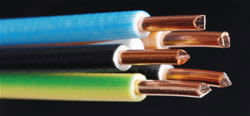Appendix 4, Current-carrying capacity and voltage drop for cables and flexible cords, has seen significant changes with the publishing of BS 7671:2008. This article looks at some of the changes and shows examples of cable calculations.

SELECTING THE correct cable for the application is imperative to ensure a satisfactory life of conductors and insulation subjected to the thermal effects of carrying current for prolonged periods of time in normal service.
Choosing the minimum size crosssectional area of conductors is essential to meet the requirements for:
- Protection against electric shock (Chapter 41)
- Protection against thermal effects (Chapter 42)
- Overcurrent protection (Chapter 43),
- Voltage drop (Section 525), and
- Limiting temperatures for terminals of equipment to which the conductors are connected (Section 526).
Current-carrying capacity and voltage drop for cables
The 17th Edition brought about some significant changes when calculating the current-carrying capacity and voltage drop for cables. For both the 16th and 17th Editions, most of the current ratings have been taken from IEC 60364-5-52 and the CENELEC HD 384.5.52 +A1 1998. These IEC and CENELEC documents do not, however, provide current ratings for armoured single-core cables, therefore, the ratings for these cables are based on data provided by ERA Technology Ltd and the British Cables Association.
The tables have been updated to reflect present cable standards and introduce current ratings for buried cables. Generally, the current ratings for commonly used cables have not changed between the 16th and 17th Editions.
Installation methods
The 16th Edition recognised 20 methods of installation, the 17th Edition, however, recognises 57 methods in Table 4A2. It is impossible, of course, to cover every possible method or installation permutation but, with the 17th Edition recognising a further 37 methods of installation, more possibilities are now covered. Note that all installation numbers in table 4A2 are different from those in the 16th Edition.
Reference method
It is impractical to calculate and publish current ratings for every installation method, since many would result in the same current rating. Therefore a suitable (limited) number of current ratings have been calculated which cover all installation methods, known as Reference Methods. There are 7 reference methods, A to G, shown in table 1 overleaf.
Click on the attachment below to read the full article including the calculation tables.
